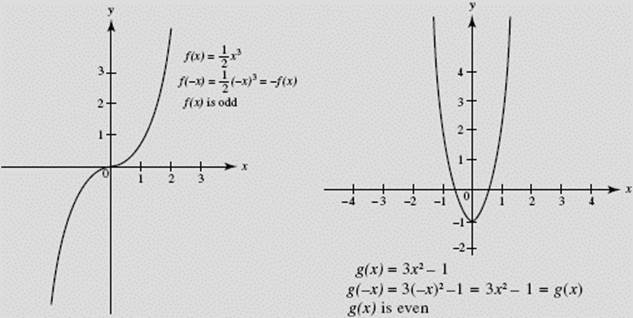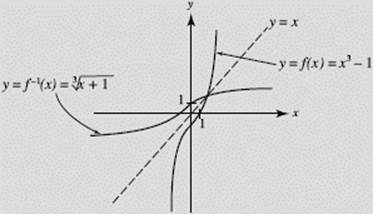Calculus AB and Calculus BC
CHAPTER 1 Functions
Concepts and Skills
In this chapter you will review precalculus topics. Although these topics are not directly tested on the AP exam, reviewing them will reinforce some basic principles:
• general properties of functions: domain, range, composition, inverse;
• special functions: absolute value, greatest integer; polynomial, rational, trigonometric, exponential, and logarithmic;
and the BC topics,
• parametrically defined curves • polar curves
Function
Domain
Range
A. DEFINITIONS
A1. A function f is a correspondence that associates with each element a of a set called the domain one and only one element b of a set called the range. We write
f (a) = b
to indicate that b is the value of f at a. The elements in the domain are called inputs, and those in the range are called outputs.
A function is often represented by an equation, a graph, or a table.
A vertical line cuts the graph of a function in at most one point.
EXAMPLE 1
The domain of f (x) = x2 − 2 is the set of all real numbers; its range is the set of all reals greater than or equal to −2. Note that

EXAMPLE 2
Find the domains of: ![]()
SOLUTIONS:
(a) The domain of ![]() is the set of all reals except x = 1 (which we shorten to “x ≠ 1”).
is the set of all reals except x = 1 (which we shorten to “x ≠ 1”).
(b) The domain of ![]()
(c) The domain of ![]() is x
is x ![]() 4, x ≠ 0 (which is a short way of writing {x | x is real, x < 0 or 0 < x
4, x ≠ 0 (which is a short way of writing {x | x is real, x < 0 or 0 < x ![]() 4}).
4}).
A2. Two functions f and g with the same domain may be combined to yield their sum and difference: f (x) + g(x) and f (x) − g(x), also written as (f + g) (x) and (f − g) (x), respectively; or their product and quotient: f (x)g(x) and f (x)/g(x), also written as (fg)(x) and (f/g) (x), respectively. The quotient is defined for all x in the shared domain except those values for which g(x), the denominator, equals zero.
EXAMPLE 3
If f (x) = x2 − 4x and g(x) = x + 1, then find ![]()
SOLUTIONS: 
Composition
A3. The composition (or composite) of f with g, written as f (g(x)) and read as “f of g of x,” is the function obtained by replacing x wherever it occurs in f (x) by g(x). We also write (f ο g) (x) for f (g(x)). The domain of (f ο g) (x) is the set of all x in the domain of g for which g(x) is in the domain of f.
EXAMPLE 4A
If f (x) = 2x − 1 and g(x) = x2, then does f (g(x)) = g(f (x))?

In general, f (g(x)) ≠ g(f (x)).
EXAMPLE 4B
If f (x) = 4x2 − 1 and g(x) = ![]() find f (g(x)) and g(f (x)).
find f (g(x)) and g(f (x)).
SOLUTIONS: f (g(x)) = 4x − 1 (x ≥ 0); ![]()
Symmetry
A4. A function f is ![]() if, for all x in the domain of f,
if, for all x in the domain of f, ![]()
The graph of an odd function is symmetric about the origin; the graph of an even function is symmetric about the y-axis.
EXAMPLE 5
The graphs of ![]() x3 and g(x) = 3x2 − 1 are shown in Figure N1–1; f (x) is odd, g(x) even.
x3 and g(x) = 3x2 − 1 are shown in Figure N1–1; f (x) is odd, g(x) even.

FIGURE N1–1
A5. If a function f yields a single output for each input and also yields a single input for every output, then f is said to be one-to-one. Geometrically, this means that any horizontal line cuts the graph of f in at most one point. The function sketched at the left in Figure N1–1 is one-to-one; the function sketched at the right is not. A function that is increasing (or decreasing) on an interval I is one-to-one on that interval.
A6. If f is one-to-one with domain X and range Y, then there is a function f −1, with domain Y and range X, such that
f −1(y0) = x0 if and only if f (x0) = y0.
The function f −1 is the inverse of f. It can be shown that f −1 is also one-to-one and that its inverse is f. The graphs of a function and its inverse are symmetric with respect to the line y = x.
To find the inverse of y = f (x),
interchange x and y,
then solve for y.
EXAMPLE 6
Find the inverse of the one-to-one function f (x) = x3 − 1.
SOLUTION:

FIGURE N1–2
Note that the graphs of f and f −1 in Figure N1–2 are mirror images, with the line y = x as the mirror.
A7. The zeros of a function f are the values of x for which f (x) = 0; they are the x-intercepts of the graph of y = f (x).
EXAMPLE 7
Find zeros of f (x) = x4 − 2x2.
SOLUTION: The zeros are the x’s for which x4 − 2x2 = 0. The function has three zeros, since x4 − 2x2 = x2 (x2 − 2) equals zero if x = 0, ![]() , or
, or ![]()